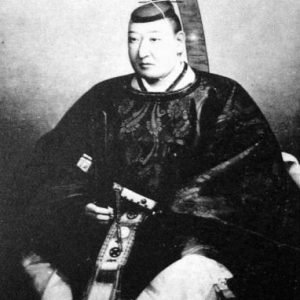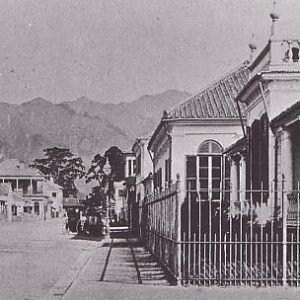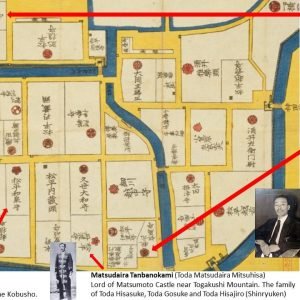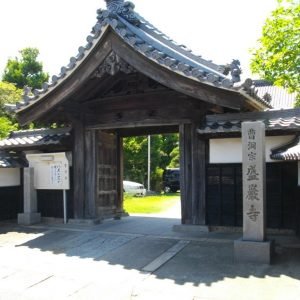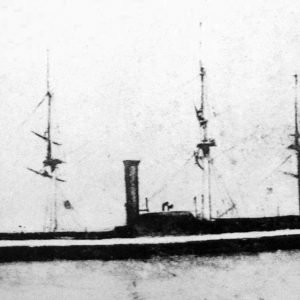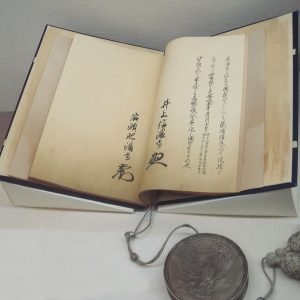Matsudaira Tadakata 松平 忠固was a Fudai daimyō (譜代大名) at the end of the Edo Period (1603~1869 CE) in a short era known as the Bakumatsu, a time that refers to the final years of the Edo period when the Tokugawa shogunate ended. A Fudai daimyō was a class of daimyō lords that were hereditary vassals of the Tokugawa in Edo-period Japan. It was primarily the fudai who filled the ranks of the Tokugawa administration.
Early in his career, Tadakata was appointed to the position of Rōjū (老中), usually translated as “Elder”. This was one of the highest-ranking government posts under the Tokugawa shogunate of Edo period Japan. He was the 6th Lord of the Ueda domain in Shinano-koku (Nagano), near Togakushi, and 8th in line as head of the Iga no Kami lineage of the Fuji-Matsudaira clan. This explains their closeness to the Toda family who ruled from nearby Matsumoto.
In 1854, at the Convention of Kanagawa (日米和親条約) and later at the 1857 Treaty of Amity and Commerce (日米修好通商条約), Tadakata acted as Rōjū for both signings. These two agreements were the first treaties between the United States and the Tokugawa shogunate. They were signed under threat of force and effectively meant the end of Japan’s 220-year-old policy of national seclusion (sakoku) by opening the ports of Shimoda and Hakodate to American vessels. It also ensured the safety of American castaways and established the position of an American consul in Japan.
While confronting Tokugawa Nariaki and his policy of “revere the emperor, expel the barbarians”, Tadakata consistently insisted on the opening of the country from start to finish, and was the mainstay that drove the opening of the shogunate to the western world.
Keeping pace with Matsudaira Tadakata was another closely related Matsudaira family member you may have heard of. The benefactor of our Toda Shinryuken Masamitsu (Hisajiro) to the Shogun’s newest military academy, the Kobusho.
Matsudaira Noriyasu 松平 乗全 selected our Toda Sensei to be one of the first swordsmanship instructors at the academy, but sadly he left his position there only after a few short years for reasons I discussed in my first book, the Hidden Lineage.
But the timing of our Toda Sensei’s leave from his position of sword instructor at the Kobusho coincides with the timing of the 1855 dismissal of both Matsudaira Noriyasu and Tadakata from their positions of Rōjū to the Shogun. The reason for this was that Tokugawa Nariaki was able to manipulate the council and instill his man, Abe Masahiro (阿部正弘) in their place. The government was now strongly leaning towards keeping the country closed and expelling all foreigners from Japan.
But after the death of Masahiro in 1857, an old-time leader who took over the council, Hotta Masayoshi (堀田正睦), in an act of restoring Matsudaira Noriyasu’s honor, promoted Noriyasu to the position of Shikouseki (伺候席). This was a position that had the Shogun’s ear, basically second to only him. In 1858 he was reinstated as a Rōjū of the council in accordance with the recommendation of Ii Naosuke. However, after the assassination of Naosuke in 1860, Noriyasu’s influence in the council faded. He retired shortly after in 1860 when he adopted his younger brother, Matsudaira Noritsune (松平 乗秩), to become his successor and lead as the head of the family.
An interesting point about Matsudaira Noritsune is that he married the daughter of Toda Ujimasa (戸田 氏正), the late Edo Period Daimyō who was the 9th Lord of the Minokuni Ogaki domain and 10th head of the Ogaki domain Toda clan. A clan that is well known to have heavily used Shinobi or “ninja”.
Matsudaira Noriyasu, Toda Shinryuken’s benefactor, died in 1870. His grave is located at Seigan Temple (盛巌寺) in Nishio City, Aichi Prefecture.
The search for the Hidden Lineage continues….
Sean Askew 導冬 Dōtō
12/20/2019
Bujinkan Kokusai Renkoumyo – BKRBUDO



